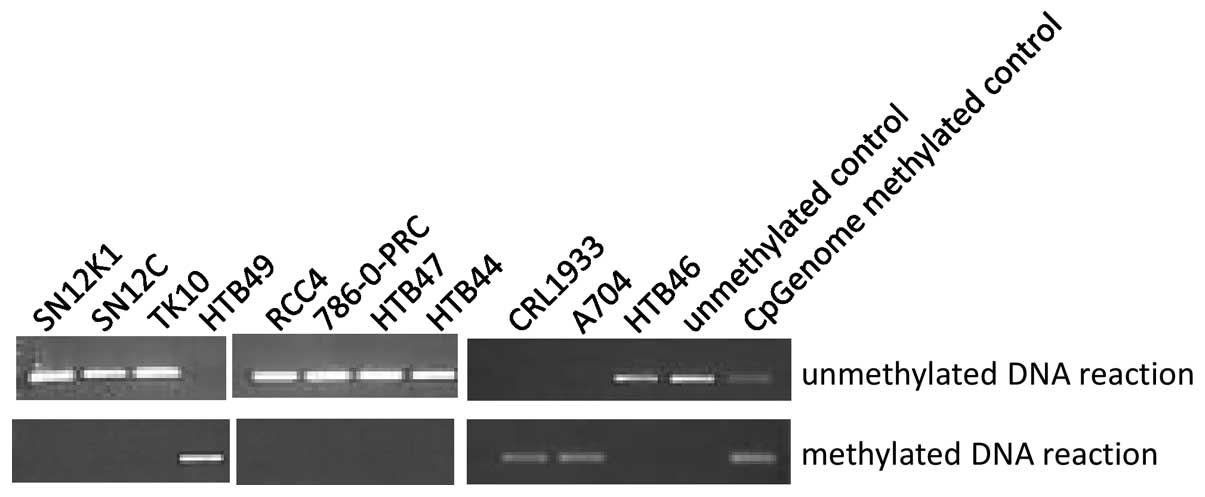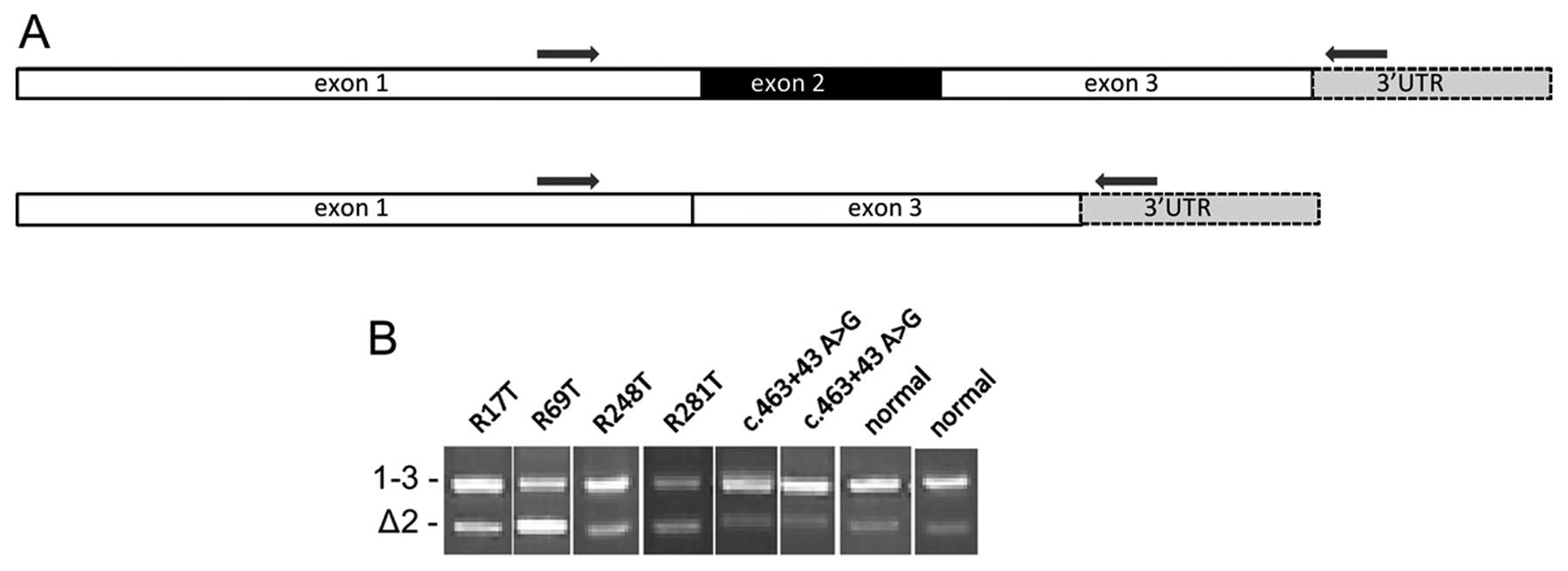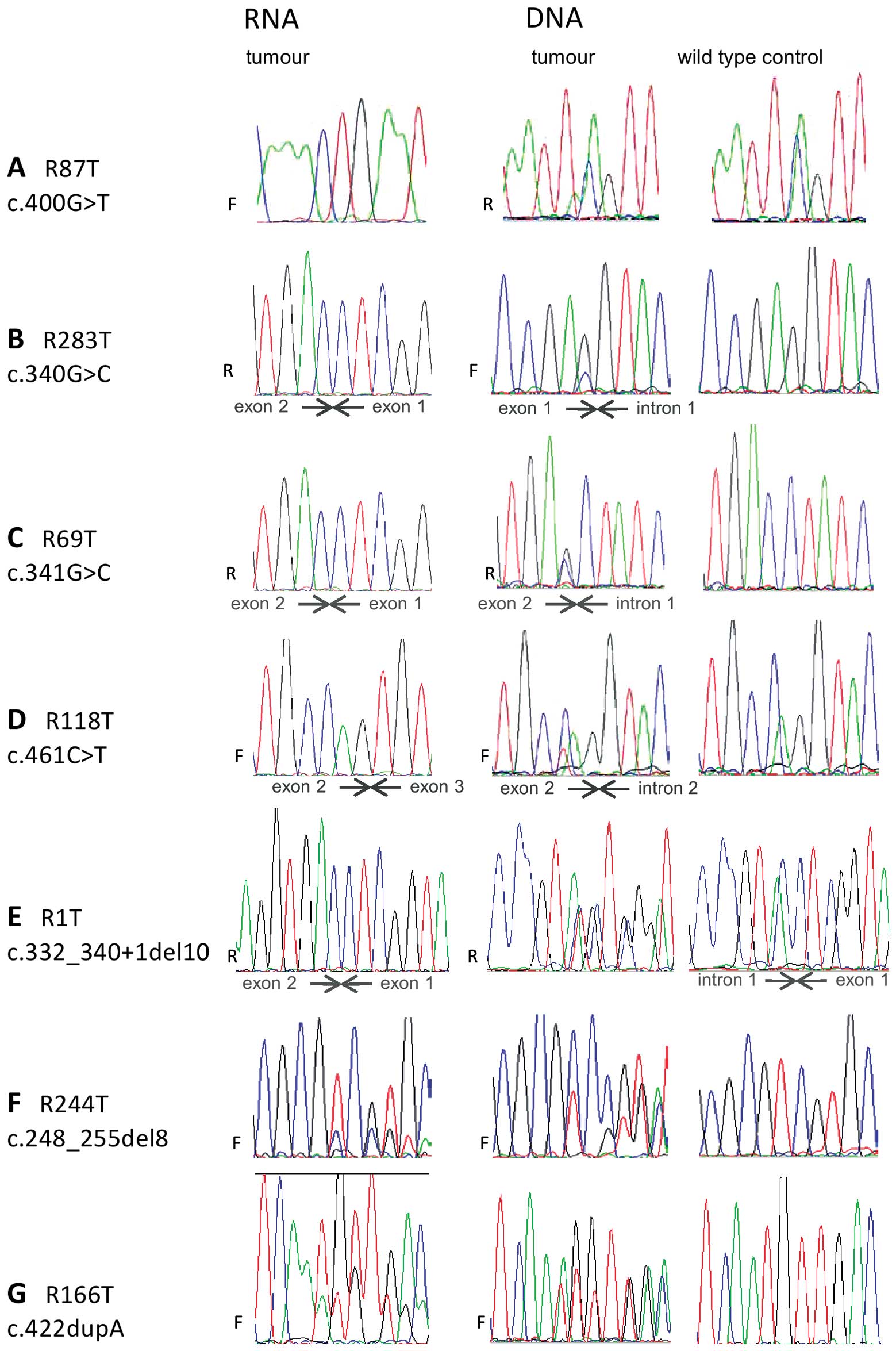|
1
|
Gnarra JR, Tory K, Weng Y, et al:
Mutations of the VHL tumour suppressor gene in renal carcinoma. Nat
Genet. 7:85–90. 1994. View Article : Google Scholar : PubMed/NCBI
|
|
2
|
Latif F, Tory K, Gnarra J, et al:
Identification of the von Hippel-Lindau disease tumor suppressor
gene. Science. 260:1317–1320. 1993. View Article : Google Scholar : PubMed/NCBI
|
|
3
|
Nordstrom-O’Brien M, van der Luijt RB, van
Rooijen E, et al: Genetic analysis of von Hippel-Lindau disease.
Hum Mutat. 31:521–537. 2010.PubMed/NCBI
|
|
4
|
Vortmeyer AO, Huang SC, Pack SD, Koch CA,
Lubensky IA, Oldfield EH and Zhuang X: Somatic point mutation of
the wild-type allele detected in tumours of patients with VHL
germline deletion. Oncogene. 21:1167–1170. 2002. View Article : Google Scholar : PubMed/NCBI
|
|
5
|
Nickerson ML, Jaeger E, Shi Y, et al:
Improved identification of von Hippel-Lindau gene alterations in
clear cell renal tumors. Clin Cancer Res. 14:4726–4734. 2008.
View Article : Google Scholar : PubMed/NCBI
|
|
6
|
Young AC, Craven RA, Cohen D, et al:
Analysis of VHL gene alterations and their relationship to clinical
parameters in sporadic conventional renal cell carcinoma. Clin
Cancer Res. 15:7582–7592. 2009. View Article : Google Scholar : PubMed/NCBI
|
|
7
|
Richards FM, Crossey PA, Phipps ME, et al:
Detailed mapping of germline deletions of the von Hippel-Lindau
disease tumour suppressor gene. Hum Mol Genet. 3:595–598. 1994.
View Article : Google Scholar : PubMed/NCBI
|
|
8
|
Richards FM, Schofield PN, Fleming S and
Maher ER: Expression of the von Hippel-Lindau disease tumour
suppressor gene during human embryogenesis. Hum Mol Genet.
5:639–644. 1996. View Article : Google Scholar : PubMed/NCBI
|
|
9
|
Schoenfeld A, Davidowitz EJ and Burk RD: A
second major native von Hippel-Lindau gene product, initiated from
an internal translation start site, functions as a tumor
suppressor. Proc Natl Acad Sci USA. 95:8817–8822. 1998. View Article : Google Scholar : PubMed/NCBI
|
|
10
|
Bradley JF and Rothberg PG: Processed
pseudogene from the von Hippel-Lindau disease gene is located on
human chromosome 1. Diagn Mol Pathol. 8:101–106. 1999. View Article : Google Scholar : PubMed/NCBI
|
|
11
|
Woodward ER, Buchberger A, Clifford SC,
Hurst LD, Affara NA and Maher ER: Comparative sequence analysis of
the VHL tumour suppressor gene. Genomics. 65:253–265. 2000.
View Article : Google Scholar : PubMed/NCBI
|
|
12
|
Stebbins CE, Kaelin WG Jr and Pavletich
NP: Structure of the VHL-ElonginC-ElonginB complex implications for
VHL tumor suppressor function. Science. 284:455–461. 1999.
View Article : Google Scholar : PubMed/NCBI
|
|
13
|
Rini BI, Campbell SC and Escudier B: Renal
cell carcinoma. Lancet. 373:1119–32. 2009. View Article : Google Scholar : PubMed/NCBI
|
|
14
|
Banks RE, Tirukonda P, Taylor C, et al:
Genetic and epigenetic analysis of von Hippel-Lindau (VHL) gene
alterations and relationship with clinical variables in sporadic
renal cancer. Cancer Res. 66:2000–2011. 2006. View Article : Google Scholar : PubMed/NCBI
|
|
15
|
Herman JG, Graff JR, Myohanen S, Nelking
BD and Baylin SB: Methylation-specific PCR a novel PCR assay for
methylation status of CpG islands. Proc Natl Acad Sci USA.
93:9821–9826. 1996. View Article : Google Scholar : PubMed/NCBI
|
|
16
|
Reese MG, Eeckman FH, Kulp D and Haussler
D: Improved splice site detection in genie. J Comp Biol. 4:311–323.
1997. View Article : Google Scholar : PubMed/NCBI
|
|
17
|
Cartegni L, Wang J, Zhu Z, Zhang MQ and
Krainer AR: ESEfinder: a web resource to identify exonic splicing
enhancers. Nucleic Acids Res. 31:3568–3571. 2003.PubMed/NCBI
|
|
18
|
Valcarcel J, Gaur RK, Singh R and Green
MR: Interaction of U2AF65 RS region with pre-mRNA of
branch point and promotion base pairing with U2 snRNA. Science.
273:1706–1709. 1996.PubMed/NCBI
|
|
19
|
Lefevre SH, Chauveinc L, Stoppa-Lyonnet D,
et al: A T to C mutation in the polypyrimidine tract of the exon 9
splicing site of the RB1 gene responsible for low penetrance
hereditary retinoblastoma. J Med Genet. 39:e212002. View Article : Google Scholar : PubMed/NCBI
|
|
20
|
Nakai K and Sakamoto H: Construction of a
novel database containing aberrant splicing mutations of mammalian
genes. Gene. 141:171–177. 1994. View Article : Google Scholar : PubMed/NCBI
|
|
21
|
Krawczak M, Thomas NST, Hundrieser B, Mort
M, Wittig M, Hampe J and Cooper DN: Single base-pair substitutions
in exon-intron junctions of human genes: nature, distribution, and
consequences for mRNA splicing. Hum Mutat. 28:150–158. 2007.
View Article : Google Scholar : PubMed/NCBI
|
|
22
|
Martella M, Salviati L, Casarin A, et al:
Molecular analysis of two uncharacterised sequence variants of the
VHL gene. J Hum Genet. 51:964–968. 2006. View Article : Google Scholar
|
|
23
|
McNeill A, Rattenberry E, Barber R,
Killick P, MacDonald F and Maher ER: Genotype-phenotype
correlations in VHL exon deletions. Am J Med Genet Part A.
149A:2147–2151. 2009. View Article : Google Scholar : PubMed/NCBI
|
|
24
|
Zhang MQ: Statistical features of human
exons and their flanking regions. Hum Mol Genet. 7:919–932. 1998.
View Article : Google Scholar : PubMed/NCBI
|
|
25
|
Wang Z and Burge C: Splicing regulation:
from a parts list of regulatory elements to an integrated splicing
code. RNA. 14:802–813. 2008. View Article : Google Scholar : PubMed/NCBI
|
|
26
|
Pohlenz J, Rosenthal IM, Weiss RE, Jhiang
SM, Burant C and Refetoff S: Congenital hypothyroidism due to
mutations in the sodium/iodide symporter. J Clin Invest.
101:1028–1035. 1998. View Article : Google Scholar : PubMed/NCBI
|
|
27
|
Pymar LS, Platt FM, Askham JM, Morrison EE
and Knowles MA: Bladder tumour-derived somatic TSC1 missense
mutations cause loss of function via distinct mechanisms. Hum Mol
Genet. 17:2006–2017. 2008. View Article : Google Scholar : PubMed/NCBI
|
|
28
|
Lorson CI, Hahnen E, Androphy EJ and Wirth
B: A single nucleotide in the SMN gene regulates splicing and is
responsible for spinal muscular atrophy. Proc Natl Acad Sci USA.
96:6307–6311. 1999. View Article : Google Scholar : PubMed/NCBI
|
|
29
|
Liu W, Qian C and Francke U: Silent
mutation induces exon skipping of fibrillin-1 gene in Marfan
syndrome. Nat Genet. 16:328–329. 1997. View Article : Google Scholar : PubMed/NCBI
|
|
30
|
Huang C-H, Reid M, Daniels G and
Blumenfeld OO: Alteration of splice site selection by an exon
mutation in the human glycophorin A gene. J Biol Chem.
268:25902–25908. 1993.PubMed/NCBI
|
|
31
|
Teraoka SN, Telatar M, Becker-Catania S,
et al: Splicing defects in the ataxia-telangiectasia gene ATM:
underlying mutations and consequences. Am J Hum Genet.
64:1617–1631. 1999. View
Article : Google Scholar : PubMed/NCBI
|
|
32
|
Eskesen ST, Eskesen FN and Ruvinsky A:
Natural selection affects frequencies of AG and GT dinucleotides at
the 5′ and 3′ ends of exons. Genetics. 167:543–550. 2004.PubMed/NCBI
|
|
33
|
Frischmeyer PA and Dietz HC:
Nonsense-mediated mRNA decay in health and disease. Hum Mol Genet.
8:1893–1900. 1999. View Article : Google Scholar : PubMed/NCBI
|
|
34
|
Holbrook JA, Neu-Yilik G, Hentze MW and
Kulozik AE: Nonsense-mediated decay approaches the clinic. Nat
Genet. 36:801–808. 2004. View
Article : Google Scholar : PubMed/NCBI
|
|
35
|
Silva AL and Romao L: The mammalian
nonsense-mediated mRNA decay pathway: to decay or not to decay!
Which players make the decision? FEBS Lett. 583:499–505. 2009.
|
|
36
|
Hamosh A, Rosenstein BJ and Cutting GR:
CFTR nonsense mutations G542X and W1282X associated with severe
reduction of CFTR mRNA in nasal epithelial cells. Hum Mol Genet.
1:542–544. 1992. View Article : Google Scholar : PubMed/NCBI
|
|
37
|
Gossage DL, Norby-Slycord CJ, Hershfield
MS and Markert ML: A homozygous 5 base-pair deletion in exon 10 of
the adenosine deaminase (ADA) gene in a child with severe combined
immunodeficiency and very low levels of ADA mRNA and protein. Hum
Mol Genet. 2:1493–1494. 1993. View Article : Google Scholar : PubMed/NCBI
|
|
38
|
Rajavel KS and Neufeld EF:
Nonsense-mediated decay of human HEXA mRNA. Mol Cel Biol.
21:5512–5519. 2001. View Article : Google Scholar : PubMed/NCBI
|
|
39
|
Perrin-Vidoz L, Sinilnikova OM,
Stoppa-Lyonnet D, Lenoir GM and Mazoyer S: The nonsense-mediated
mRNA decay pathway triggers degradation of most BRCA1 mRNAs bearing
premature truncation codons. Hum Mol Genet. 11:2805–2814. 2002.
View Article : Google Scholar : PubMed/NCBI
|
|
40
|
Inacio A, Silva AL, Pinto J, et al:
Nonsense mutations in close proximity to the initiation codon fail
to trigger full nonsense-mediated mRNA decay. J Biol Chem.
279:32170–32180. 2004. View Article : Google Scholar : PubMed/NCBI
|
|
41
|
Nagy E and Maquat LE: A rule for
termination-codon position within intron-containing genes: when
nonsense affects RNA abundance. Trends Biochem Sci. 23:198–199.
1998. View Article : Google Scholar : PubMed/NCBI
|
|
42
|
Ong KR, Woodward ER, Killick P, Lim C,
Macdonald F and Maher ER: Genotype-phenotype correlations in von
Hippel-Lindau disease. Hum Mutat. 28:143–149. 2007. View Article : Google Scholar : PubMed/NCBI
|
|
43
|
Micale L, Muscarella LA, Marzulli M, et
al: VHL frameshift mutation as target of nonsense-mediated mRNA
decay in Drosophila melanogaster and human HEK293 cell line.
J Biomed Biotechnol. 2009:8607612009. View Article : Google Scholar : PubMed/NCBI
|
|
44
|
Herman JG, Latif F, Weng Y, et al:
Silencing of the VHL tumour-suppressor gene by DNA methylation in
renal carcinoma. Proc Natl Acad Sci USA. 91:9700–9704. 1994.
View Article : Google Scholar : PubMed/NCBI
|
|
45
|
Zbar B, Kishida T, Chen F, et al: Germline
mutations in the von Hippel-Lindau disease (VHL) gene in families
from North America, Europe and Japan. Hum Mutat. 8:348–357. 1996.
View Article : Google Scholar : PubMed/NCBI
|
|
46
|
Highsmith WE, Burch LH, Zhou Z, et al: A
novel mutation in the cystic fibrosis gene in patients with
pulmonary disease but normal sweat chloride concentrations. New
Engl J Med. 331:974–980. 1994. View Article : Google Scholar : PubMed/NCBI
|
|
47
|
Christie PT, Harding B, Nesbit MA, Whyte
MP and Thakker RV: X-linked hypophosphatemia attributable to
pseudoexons of the PHEX gene. J Clin Endocrinol Metab.
86:3840–3844. 2001. View Article : Google Scholar : PubMed/NCBI
|
|
48
|
Whaley JM, Naglich J, Gelbert L, et al:
Germ-line mutations in the von Hippel-Lindau tumor-suppressor gene
are similar to somatic von Hippel-Lindau aberrations in sporadic
renal cell carcinoma. Am J Hum Genet. 55:1092–1102. 1994.PubMed/NCBI
|
|
49
|
Maxwell PH, Wiesener MS, Chang GW, et al:
The tumour suppressor protein VHL targets hypoxia-inducible factors
for oxygen-dependent proteolysis. Nature. 399:271–275. 1999.
View Article : Google Scholar : PubMed/NCBI
|
|
50
|
Ikediobi ON, Davies H, Bignell G, et al:
Mutation analysis of 24 known cancer genes in the NCI-60 cell line
set. Mol Cancer Ther. 5:2606–2612. 2006. View Article : Google Scholar : PubMed/NCBI
|












